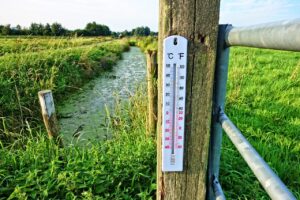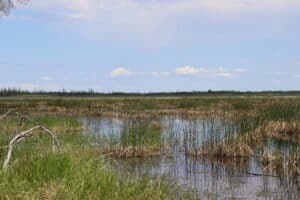In the Amazon Rainforest, there is no such thing as a natural fire. Yet every year we see headlines of rainforest vegetation aflame, smoke drifting across populated areas, and stored carbon spilling into the atmosphere. So how does a rainforest—one of the wettest ecosystems on Earth—catch fire?
Climate impacts on Amazon fire
Whether directly or indirectly, human activities are the root cause of fire in the Amazon.
In order for a fire to start anywhere, you need three things— favorable climatic conditions, a fuel source, and an ignition source. In the Amazon, each side of this “triangle of fire” has been exacerbated by warming temperatures and deforestation, creating flammable conditions that can allow fires to spread out of control deep into the forest once they are ignited.
Climate conditions
High temperature and dryness combine to create the right conditions for fires to spread through the Amazon. As global temperatures have risen, the Amazon region has become hotter and drier, more vulnerable to prolonged droughts and extreme climatic events. Most recently, a climate-driven drought spanning 2023 and 2024 has deeply impacted water levels in the forest— to the point of isolating riverside communities.
Wildfire danger days, or days considered hot and dry enough to increase the likelihood of fire, have become a much more common occurrence deeper in the Amazon, where previously it was just too wet to burn.
Fuel
Felled trees and dry vegetation form the fuel for more fires in the Amazon. How do the trees fall? Some are killed in extreme drought and previous fire, but many are intentionally cut, pushed over by bulldozers for conversion of forest to pasture land. Large-scale deforestation has been advancing into the Amazon for decades, fragmenting thick blocks of forest and replacing them with ranch or farm land. Scientists and activists have been pushing for an urgent stop in deforestation to achieve, among other benefits, a drop in fire numbers. However, despite slowly declining deforestation rates, fires are still increasing, pointing to another important piece of the puzzle – degradation.
When a forest is fragmented by deforestation, it degrades the vegetation that remains standing. Forests along the edges of clearings dry out and weaken, making them more susceptible to future burning. And burning weakens nearby forests yet again, creating more available fuel, setting off a chain of degradation.
Ignition
Ignition in the Amazon is almost entirely human caused— whether accidentally or intentionally. Ranch and farm operations both legally and illegally clearing Amazon rainforest use fire to burn away cut vegetation or prepare existing pasture land for other uses. With climate change creating hotter and drier conditions, and lengthening the dangerous dry season, any ignition becomes potentially risky, whether or not its use is legalized. Especially where forest edges have already been weakened.
However, a study led by Woodwell Climate Postdoctoral Researcher and fire ecologist Dr. Manoela Machado, found that long-term solutions to the Amazon’s fire crisis will require distinguishing between the complex uses of fire. One-size-fits-all fire bans, usually employed as emergency measures and not always strictly enforced, may reduce fire in the short term, but don’t adequately address the underlying reasons people have decided to burn the land.
Ending deforestation and supporting firefighters
Fire in the Amazon follows deforestation and degradation, namely from logging, fires, droughts and fragmentation. Climate change and human encroachment have worked in concert to foster a devastating annual burning regime in the Amazon rainforest that threatens one of the Earth’s most valuable mechanisms for keeping the planet cool.
Eliminating fire from the Amazon will require the elimination of deforestation and degradation sources, as well as the enforcement of strategic fire bans and support of firefighting brigades. Machado, has led several successful workshops with Indigenous fire brigades in Brazil, bringing together groups from across the country to learn about Geographic Information Systems (GIS) technology they can use to monitor and manage their own forests.
According to Machado, a big part of fire prevention happens in the off-season. Support for activities like community outreach, building fire breaks in collaboration with farmers, and technical assistance to replace legal use of fire, can all help reduce the prevalence of catastrophic fires when the dry-season comes around.
The Amazon is a massive place, and firefighting can be a dangerous job. Especially on the frontiers of deforestation, where land grabbing and illegal deforestation are common and fire fighters are often threatened to stay out of an area. Ultimately, government support, bolstered enforcement of deforestation laws, and viable alternative livelihoods have a major role to play in bringing down fires, alongside continued global efforts to curb climate change.
Permafrost Pathways’ recommendations for urgent congressional action
Rising temperatures across the Circumpolar North are catalyzing more severe and intense environmental hazards in the US-Arctic region. Among the most dangerous trends is thawing permafrost, i.e., the loss of continuously frozen ground that underlies roughly 38% of land surface in Alaska. As permafrost thaws, it destabilizes critical infrastructure, destroying homes, schools, roads, and public utilities. Compounding effects of flooding, erosion, and thaw-induced ground collapse pose imminent environmental threats for at least 144 Alaska Native communities. Permafrost thaw also holds global significance, as it contains an estimated 1.4 trillion tons of carbon, or roughly twice as much carbon as is currently in the Earth’s atmosphere. Without aggressive, near-term climate mitigation, resulting greenhouse gas emissions (carbon dioxide and methane) from permafrost thaw and increasingly intense wildfires in the Arctic-boreal region may be on par with the highest-emitting countries. Fortunately, Permafrost Pathways understands these challenges and is working to leverage the best available science to avoid worst climate scenarios and to advance equitable adaptation responses to permafrost thaw.
The policy recommendations linked to the right are informed by active collaboration with Arctic communities, scientific experts, youth leaders, and innovators in both the public and private sectors. They are intended to align with current US federal policies, including those named in the 2022 National Strategy for the Arctic Region and its Implementation Plan (2023), which identified Permafrost Pathways as a key partner in US government efforts to advance a more resilient and secure Arctic region.
Learn more on Permafrost Pathways’ website.
Hottest summer on record could lead to the warmest year ever measured

Summer 2024 sweltered to Earth’s hottest on record, making it even more likely that this year will end up as the warmest humanity has measured, European climate service Copernicus reported Friday.
And if this sounds familiar, that’s because the records the globe shattered were set just last year as human-caused climate change, with a temporary boost from an El Nino, keeps dialing up temperatures and extreme weather, scientists said.
Read more on Associated Press News.
How climate models help us see into the Arctic’s future
Asked to picture an Arctic scientist, you might first think of someone in a red field parka navigating sea ice in an inflatable dinghy or measuring snow depth on an expanse of treeless tundra. But much of what we’re learning about Northern ecosystems and what the region’s future could look like comes from scientists sitting before screens, working with code and supercomputers. These researchers train sets of complex equations called models that make valuable predictions about the future climate and its impacts based on what we know about how ecosystems work and what we’ve observed in the past.
Read more on Permafrost Pathways.
New legislation proposed in the U.S. Senate would for the first time consider the importance of monitoring permafrost thaw as part of a broader effort to improve U.S. weather forecasting and modeling, and support cutting-edge tools and resources to better track this serious environmental hazard in the North.
Read more on Permafrost Pathways.
Thawing Alaskan permafrost is unleashing more mercury, confirming scientists’ worst fears
“It has that sense of a bomb that’s going to go off.”

Alaska’s permafrost is melting and revealing high levels of mercury that could threaten Alaska Native peoples.
That’s according to a new study released earlier this month by the University of Southern California, analyzing sediment from melted permafrost along Alaska’s Yukon River.
Researchers already knew that the Arctic permafrost was releasing some mercury, but scientists weren’t sure how much. The new study — published in the journal Environmental Research Letters — found the situation isn’t good: As the river runs west, melted permafrost is depositing a lot of mercury into the riverbank, confirming some of scientists’ worst estimates and underscoring the potential threat to the environment and Indigenous peoples.
Fire is a necessary element in northern forests, but with climate change, these fires are shifting to a far less natural regime— one that threatens the ecosystem instead of nurturing it.
Boreal tree species, like black spruce, have co-evolved over millennia with a steady regime of low-frequency, high-intensity fires, usually ignited by lightning strikes. These fires promote turnover in vegetation and foster new growth. On average, every 100 to 150 years, an intense “stand-replacing” fire might completely raze a patch of forest, opening a space for young seedlings to take root.
But rapid warming in northern latitudes has intensified this cycle, sparking large fires on the landscape more frequently, jeopardizing regeneration, and releasing massive amounts of carbon that will feed additional warming. Here’s how climate change is impacting boreal fires.
Climate Impacts on Boreal Fire
In order for a fire to start, you need three things— favorable climatic conditions, a fuel source, and an ignition source. These elements, referred to as the triangle of fire, are all being exacerbated as boreal forests warm, resulting in a fire regime with much larger and more frequent fires than the forests evolved with.
Climate conditions
Forest fires only ignite in the right conditions, when high temperatures combine with dryness in the summer months. As northern latitudes warm at a rate three to four times faster than the rest of the globe, fire seasons in the boreal have lengthened, and the number of fire-risk days have increased.
In some areas of high-latitude forest, climate change has changed the dynamics of snowfall and snow cover disappearance. The rate of spring snowmelt is often an important factor in water availability on a landscape throughout the summer. A recent paper, led by Dr. Thomas Hessilt of Vrije University in collaboration with Woodwell Associate Scientist, Dr. Brendan Rogers, found that earlier snow cover disappearance resulted in increased fire ignitions. Early snow disappearance was also associated with earlier-season fires, which were more likely to grow larger— on average 77% larger than historical fires.
Fuel
The second requirement for fires to start is available “fuel”. In a forest, that’s vegetation (both living and dead) as well as carbon-rich soils that have built up over centuries. Here, the warming climate plays a role in priming vegetation to burn. A paper co-authored by Rogers has demonstrated temperatures above approximately 71 F in the forest canopy can be a useful indicator for the ignition and spread of “mega-fires,” which spread massive distances through the upper branches of trees. The findings suggest that heat-stressed vegetation plays a big role in triggering these large fires.
Warming has also triggered a feedback loop around fuel in boreal systems. In North America, the historically dominant black spruce is struggling to regenerate between frequent, intense fires. In some places, it is being replaced by competitor species like white spruce or aspen, which don’t support the same shaded, mossy environment that insulates frozen, carbon-rich soils called permafrost, making the ground more vulnerable to deep-burning fires. When permafrost soils thaw and burn, they release carbon that has been stored—sometimes for thousands of years—contributing to the acceleration of warming.
Ignition
Finally, fires need an ignition source. In the boreal, natural ignitions from lightning are the most frequent culprit, although human-caused ignitions have become more common as development expands into northern forests.
Because of lightning’s ephemeral nature, it has been difficult to quantify the impacts of climate change on lightning strikes, but recent research has shown lightning ignitions have been increasing since 1975, and that record numbers of lightning ignitions correlated with years of record large fires. Some models indicate summer lightning rates will continue to increase as global temperatures rise.
There is also evidence showing that a certain type of lightning— one more likely to result in ignition— has been increasing. This “hot lightning” is a type of lightning strike that channels an electrical charge for an extended period of time and tends to correlate more frequently with ignitions. Analysis of satellite data suggests that with every one degree celsius of the Earth’s warming, there might be a 10% increase in the frequency of these hot lightning strikes. That, coupled with increasingly dry conditions, sets the stage for more frequent fire ignitions.
Fire Management as a Climate Solution
So climate change is intensifying every side of the triangle of fire, and the combined effects are resulting in more frequent, larger, more intense blazes that contribute more carbon to the atmosphere. While the permanent solution to bring fires back to their natural regimes lies in curbing global emissions, research from Woodwell Climate suggests that firefighting in boreal forests can be a successful emissions mitigation strategy. And a cost effective one too— perhaps as little as $13 per metric ton of carbon dioxide avoided, which puts it on par with other carbon mitigation solutions like onshore wind or utility-scale solar. It also has the added benefit of protecting communities from the health risk of wildfire smoke.
Rogers, along with Senior Science Policy Advisor, Dr. Peter Frumhoff, and Postdoctoral researcher Dr. Kayla Mathes have begun work in collaboration with the Yukon Flats National Wildlife Refuge in Alaska to pilot this solution as part of the Permafrost Pathways project. Yukon Flats is underlain by large tracts of particularly carbon-rich permafrost soils, making it a good candidate for fire suppression tactics to protect stored carbon.
The project will be the first of its kind— working with communities in and around the Refuge as well as US agencies to develop and test best practices around fighting boreal fires specifically to protect carbon. Broadening deployment of fire management could be one strategy to mitigate the worst effects of intensifying boreal fires, buying time we need to get global emissions in check.




